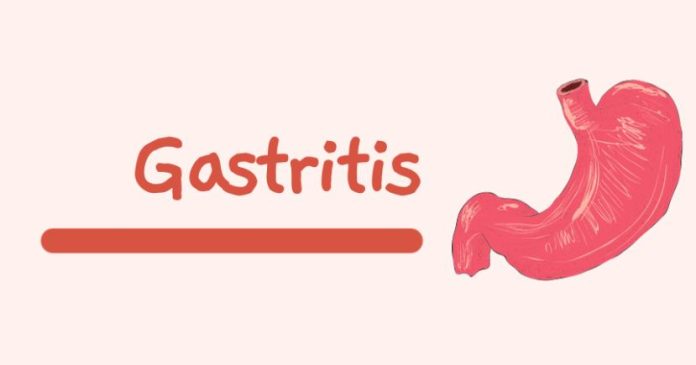Gastritis
- It is an inflammation of the gastric mucosa. ( inner lining of the stomach)
- It is one of the most common GI problems.
- It refers to diffuse localized responses of the gastric mucosa to injury or infection.
Layers in stomach
- Mucosa
- Submucosa
- Muscle layer
- serosa
Types of Gastritis
- Acute Gastritis
- Chronic Gastritis
According to the position
- Antral gastritis
- Gastritis body of the stomach
- Pangastritis
acute gastritis
- It is short term inflammatory process that can be initiated by numerous factors in stomach
- may last several hours to a few days.
Acute Gastritis Etiology and Risk Factors
- Dietary indication
- Overuse of aspirin and other NSAIDs
- Excessive alcohol intake
- Bile reflux disease
- Stress
- Bacterial and fungal infection
- Old age
- Radiation therapy, chemotherapeutic damages, steroids, and digitalis.
- Excessive intake of tea, coffee, mustard, pepper, etc.
- Other disease
Pathophysiology of gastritis
- The mucosal lining of the stomach normally protects it from the action of gastric acid. This mucosal barrier is composed of prostaglandins.
- If this barrier is penetratedà gastritis occurs leading to injury to mucosa and small vessels causing edema, hemorrhage, and possible ulcer formation.
Clinical features of acute gastritis
- Abdominal epigastric discomfort, tenderness, headache, severe nausea, anorexia, vomiting and hiccupping.
- Sometimes no symptoms may occur.
- Cramping, belching, reflux, sometimes hematemesis and GI bleeding.
Chronic Gastritis
- It is a prolonged inflammation of the gastric mucosa or the stomach.
- It can result from repeated episodes of acute gastritis.
Etiology of chronic gastritis
- Helicobacter pylori (H-pylori) cause chronic atrophic gastritis
- Gastric surgery
- Acute recurrent gastritis
- More common in older adults
- Benign or malignant ulcers of the stomach
- Autoimmune diseases
- Pernicious anemia,
- caffeine,
- NSAIDs, alcohol,
- smoking,
- reflux of intestinal content into the stomach
Pathophysiology of chronic gastritis
Clinical features
- Anorexia
- Heart burn after eating
- Sour taste on mouth
- Feeling of fullness
- Dyspepsia
- Epigastric pain
- Vomiting
- Intolerance of spicy or fatty foods
- Mal-absorption
- Weight loss
Peptic Ulcer
- A peptic ulcer may be referred to as a gastric, duodenal, or esophageal ulcer, depending on its location.
- A peptic ulcer is an excavation (hollowed-out area) that forms in different parts of the stomach
- mucosal wall of the stomach,
- pylorus (the opening between the stomach and duodenum),
- duodenum (the first part of the small intestine), or in the esophagus.
- Erosion of a circumscribed area of mucous membrane is the cause.
- This erosion may extend as deeply as the muscle layers or through the muscle to the peritoneum.
- Peptic ulcers are more likely to occur in the duodenum than in the stomach.
- As a rule they occur alone, but they may occur in multiples.
Epidemiology
- Greatest frequency in people between 40 and 60 years of age.
- It is relatively uncommon in women of childbearing age, but it has been observed in children and even in infants.
- After menopause, the incidence of peptic ulcers in women is almost equal to that in men.
- Etiology
- H. pylori infection (90% has this bacterium)
- The ingestion of milk and caffeinated beverages, smoking, and alcohol also may increase HCl secretion.
- Stress and eating spicy foods may make peptic ulcers worse.
- Familial tendency also may be a significant predisposing factor.
Zollinger Ellison syndrome.
Chronic use of NSAIDs, alcohol ingestion, and excessive smoking.
Types of peptic ulcer disease
- Gastric peptic ulcer
- Duodenal peptic ulcer
Stomach function
Digestion of food
- Storage of food
- Secretion of gastric juices
- Secretion of digestive enzymes
- Secretion of HCL
- Secretion of Gastric hormones
- Secretion of intrinsic factor
- Absorption of water
Gastric Ulcers and Duodenal Ulcers
- DUs occur most often in the first portion of duodenum (>95%), with ~90% located within 3 cm of the pylorus.
- Malignant DUs are extremely rare.
- In contrast to DUs, GUs can represent a malignancy.
- Benign GUs are most often found along the lesser curvature in the region of pyloric antrum.
Pathophysiology
- Duodenal Ulcer by H. Pylori Infection
Clinical manifestations
- Typical symptoms
- Epigastric pain
- Fullness
- Nausea
- Bloating
- Nocturnal pain
Alarm symptoms
- Anemia (bleeding)
- Hematemesis
- Melena
- Pyrosis (heartburn)
- Weight loss
- Persisting abdominal pain often radiating to the back
